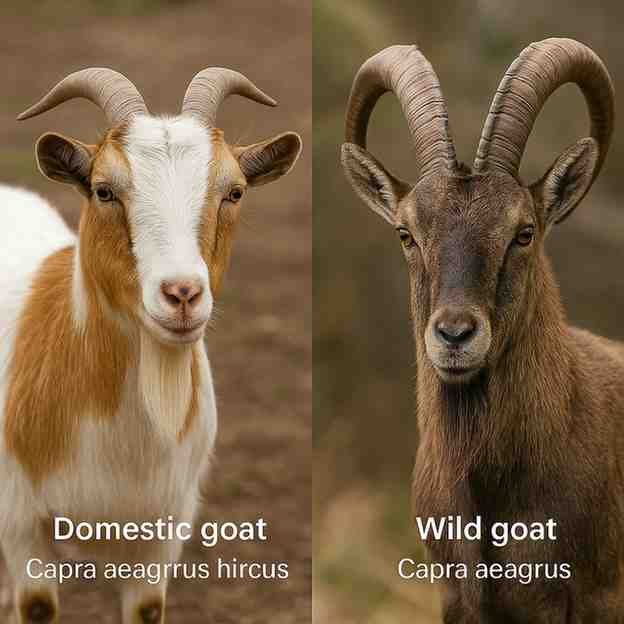What is the scientific name of a goat? What is the scientific name of a goat? The goat scientific name is Capra hircus, and Capra aegagrus hircus is the scientific name for a common and domestic goat.
The domestic goat, a farm animal, is raised mainly for milk, meat, fiber, and skins. While many of the general populace are unaware of its scientific name, phylum, taxonomy, and the meaning of the goat’s scientific name.
This article will help to learn about the scientific name of a goat, genus, taxonomy, scientific name meaning, types, pronunciation, and sound in general.
Table of Contents
What is the scientific name for a goat?
The goat’s sciences name is Capra aegagrus hircus, as this is the presently accepted zoological name for the domestic goat according to modern classification.

These are the breakdowns:
- Genus: Capra
- Species: aegagrus
- Subspecies: hircus
Thus, the biological name for a goat, Capra aegagrus hircus, shows that the domestic goat is a subspecies of the wild goat.
Scientific Name of a Goat Pronunciation and Sound
The scientific name of a goat is pronounced as:
/ˈkæp.rə ˌiː.ɡə.ɡrəs ˈhɜːr.kəs/
All goats have a vocal sound called “bleat” that can, more or less, be identified with “baa” or “meh.” In a farm setting, the sound will be the identity given to the goat’s feelings, mood, and needs.
So, let us clarify once again:
- Goat scientific name pronunciation English: KAH-pra HER-kus
- Goat animal sound: Bleating
Meaning of Goat’s Biological Name
The Capra aegagrus hircus has certain meanings in Latin:
- Capra means goat in Latin.
- Aegagrus refers to wild goats.
- Hircus means a he goat, or male goat.
Therefore, the full scientific name recognizes that this form of goat is domesticated from a species of wild goat and makes it easier for scientists to identify and classify it.
Goat Biological Classification and Taxonomy
| Taxonomic Rank | Classification |
|---|---|
| Kingdom | Animalia |
| Phylum | Chordata |
| Class | Mammalia |
| Order | Artiodactyla |
| Family | Bovidae |
| Subfamily | Caprinae |
| Genus | Capra |
| Species | aegagrus |
| Subspecies | hircus |
This is the exact zoological structure used in scientific records. All domestic goats follow this classification.
Why is the scientific name of the goat important?
The zoological name of a goat clarifies any confusion. Common names change with languages and regions. But this Latin name is the same all over the world.
Scientists, farmers, and veterinarians use the goat’s scientific name to:
- Identify goat breeds
- Keep medical records
- Study the behavior and genetics of the goat
- Trade livestock internationally
- Understand evolution
Thus, knowing the biological name for the goat will prove beneficial in various fields.
Goat Genus and Species Explained
What is the Genus of a Goat?
The genus of goat is Capra, which includes:
- Domestic goat
- Wild goats
- Ibex
- Makhor
All these animals belong to the same genus since they have similar characteristics, like horn structure and digestive systems.
What is the Species of a Goat?
The goat species is aegagrus, referring to wild goats. The domestic goat is a subspecies of the wild goat, which is why its full name is Capra aegagrus hircus.
Types of Goats Based on Breed
There are many types of goats in the world. Although the scientific name for the goat is the same, breeds vary depending on location and purpose. Some common types include:
Dairy Goat Breeds
- Saanen
- Alpine
- Nubian
- Toggenburg
- LaMancha
Meat Goat Breeds
- Boer
- Kiko
- Spanish
- Savanna
Fiber Goat Breeds
- Angora (produces mohair)
- Cashmere (produces cashmere wool)
Each type still falls under the same scientific name for goat, Capra aegagrus hircus.
Interesting facts about goats
| Goat Fact | Details |
|---|---|
| Common Name | Goat |
| Scientific Name | Capra aegagrus hircus |
| Animal Type | Mammal |
| Size (Length) | 1.2 to 1.5 meters (4 to 5 feet) |
| Height (Shoulder) | 50 to 90 cm (20 to 35 inches) |
| Weight (Adult Goat) | 45 to 140 kg (100 to 310 lbs), depending on breed |
| Lifespan | 10 to 18 years |
| Diet Type | Herbivore (eats plants, grasses, leaves, shrubs) |
| Domesticated | Yes (since around 10,000 years ago) |
| Habitat (Wild Goats) | Mountains, grasslands, rocky regions |
| Habitat (Domestic) | Farms, villages, rural areas |
| Common Uses | Milk, meat, fiber (wool), leather, and sometimes pets |
| Sound | Bleat (“baa” or “meh”) |
| Reproduction | Average 1–3 kids per birth |
| Gestation Period | Around 150 days (5 months) |
| Behavior | Social, curious, herd animals |
| Climbing Ability | Excellent; goats are natural climbers and balance well |
Also read:
- Discover The Cow Scientific Name and Proper Classification
- Sheep Scientific name, Genus, Meaning, Types, and Classification
Frequently Asked Questions About Goat
What is the scientific name of a goat?
The scientific name of a goat is Capra aegagrus hircus.
Is the scientific name of a wild goat different?
Yes. The scientific name of a wild goat is Capra aegagrus.
What sound does a goat make?
Goats make a bleating sound. It is often written as “baa” or “meh.”
What does Capra aegagrus hircus mean?
It means “domesticated goat” from the wild goat species.

